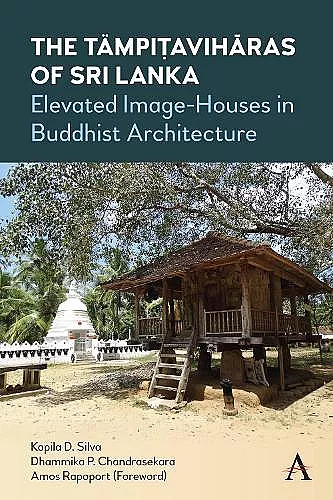The Tämpiṭavihāras of Sri Lanka
Elevated Image-Houses in Buddhist Architecture
Kapila D Silva author Dhammika P Chandrasekara author
Format:Hardback
Publisher:Anthem Press
Published:6th Jul '21
Should be back in stock very soon

Focuses on the distinctive ṭämpiṭavihāra tradition of Buddhist architectural practice from pre-modern Sri Lanka, richly illustrated with photographs and drawings
The Ṭämpiṭavihāras of Sri Lanka focuses on one distinctive Buddhist architectural practice from pre-modern Sri Lanka – the construction of Buddha image-houses on elevated wooden platforms supported by stone pillars.
The Ṭämpiṭavihāras of Sri Lanka focuses on one distinctive Buddhist architectural practice from pre-modern Sri Lanka – the construction of Buddha image-houses on elevated wooden platforms supported by stone pillars. As a centre of Buddhism, Sri Lanka has a rich tradition of erecting Buddha image-houses, the origin of which dates to the fifth century. Yet, the ṭämpiṭavihāra tradition only existed from the thirteenth to the nineteenth centuries. The ṭämpiṭavihāra is an exceptional type of image-house, not only for its specific timeframe and unique construction technology, but also for its complex architectural conception of the Buddhist worldview and soteriology. This book examines the significant aspects of ṭämpiṭavihāra architecture and documents some of the distinctive examples of ṭämpiṭavihāra with an analysis of their architectural design and symbolic content.
‘This book, a product of 20-years of journey to experience and reveal the spirit of place and distinctiveness of built structure, is a landmark presenting the continuity of history since late medieval period, as illustrated by the distinct shrines built on stone pillars, called ṭämpiṭavihāra. I am sure this will open new avenues for further research.’ — Prof. Rana P.B. Singh, President- Asian Cultural Landscape Association
‘The Tämpiṭavihāras of Sri Lanka makes an invaluable addition to literature on regional Buddhist religious literature. Its excellent documentation, analysis and presentation of architecture, materials and methods of construction, artistic embellishments as well as vernacular nuances and terminologies of Tämpiṭavihāras, along with the Brikshya-chaitya and the Stupa, raises the book to a laudable act of conservation. I find its creative use of classroom and field learning experiences of students and teachers refreshing, instructive and worth emulating.’ — Sudarshan Raj Tiwari, Lumbini College of Buddhism and Himalayan Studies, Lumbini Buddhist University
‘The authors provide a systematic and in-depth introduction to Buddhism's history and the tradition of Buddhist heritage in Sri Lanka. The book reveals the hidden treasure of Sri Lankan architecture that was previously understudied or less known. I applaud this book's publication as a valuable addition to the repository of knowledge of Asian architecture. It is indeed an important step to transform Asia from a knowledge consumer into a knowledge producer and a substantial contribution to Architectural discourse in general.’ —Dr Johannes Widodo, Director of Graduate Programs in Architectural Conservation, National University of Singapore
ISBN: 9781785277498
Dimensions: 229mm x 153mm x 26mm
Weight: 454g
194 pages